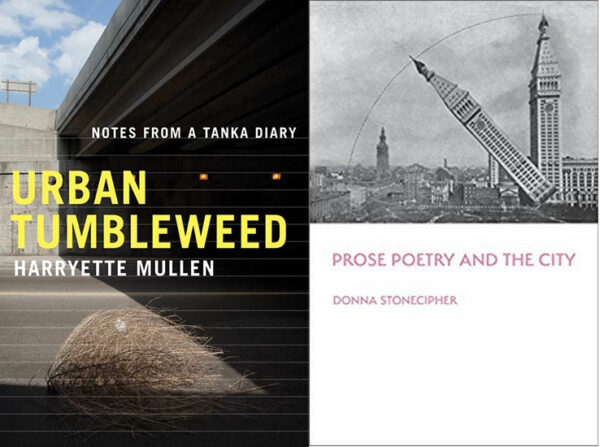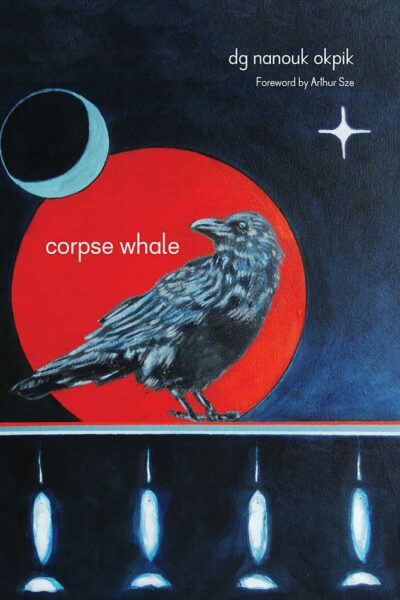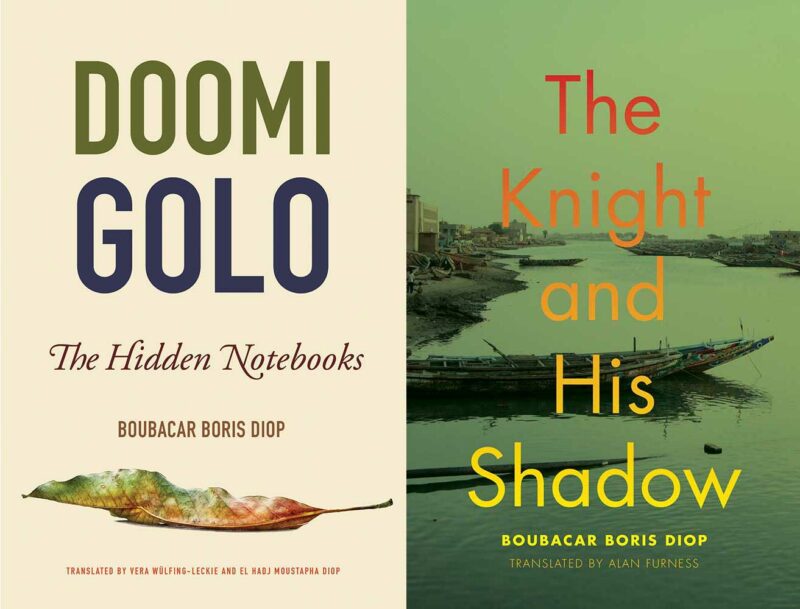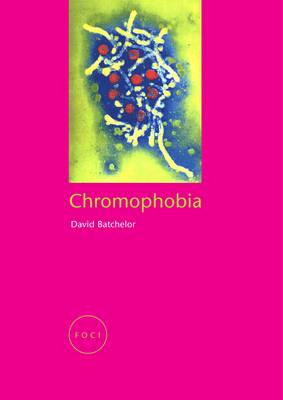corpse whale, dg nanouk okpik (University of Arizona Press, 2012)
Much of my reading is informed by friends and, in fact, much of my reading is their poetry. I love the depth and richness of following a friend’s work through conversations and sharing, to witness its arcs, experiments and revisions. But at the same time, I try to stay alert to the sometimes-treacherous allure of staying within my social circle, my comfort zone. So when I took up a friend’s recent recommendation to read dg nanouk okpik’s corpse whale, it felt the best of both worlds. The Inuit culture and arctic environment from which okpik writes is distant from my own, inner-city dweller that I am, accustomed to close quarters, constricted horizons, conspicuous consumption, hot summers and relatively warm (and warmer) winters. But my environment and okpik’s are yet connected—the FDR traffic I see from my window is affecting the “garnet-cloaking icebergs” that the narrator watches while “lying in the onyx rain” (“Drying Magma Near Illiamna”). And this connection isn’t just current—in that same poem, okpik writes of the past in future tense, “the men in black cloaks will mutilate our known selves.” In environmental catastrophe and cultural annihilation, past, present and future are crushed into simultaneity. The still-powerful technology of books works to connect me to a place very different from mine, yet so impacted by what I am part of here.
Doomi Golo: The Hidden Notebooks by Boubacar Boris Diop, translated by Vera Wülfing-Leckie and El Hadji Moustapha Diop (Michigan State University Press, 2016). The Knight and His Shadow by Diop, translated by Alan Furness (Michigan State University Press, 2015)
Doomi Golo: The Hidden Notebooks is the first novel to be translated from Wolof to English and the first novel to be written in Wolof by Senegalese author Boubacar Boris Diop. I’d read Diop’s novel The Knight and His Shadow (originally written in French) and saw in Doomi Golo a continuation of his investigation into narrative (more on this in a bit). But unlike The Knight and His Shadow and the French translation of Doomi Golo, the translators decided to keep certain words and phrases in the original Wolof. Doomi Golo itself roughly translates into “Children of the Monkey/She-Ape,” but I see the decision to keep the original Wolof title as making a crucial point. A mother makes a terrible bargain in order to change from a black woman to a white one—and her two traumatized children may be/might transform into monkeys as the result. The trio’s unsettled states of being trouble the entire community, and also point to the depthless complexities of the colonial and post-colonial histories of Senegal (although Rwanda is also a reference). An English translation would have separated that key term, Doomi Golo, from its language, and diluted its full resonance. The translators’ excellent introduction also provides a deeper understanding of what it means to write into and alongside the Wolof oral tradition, including the relationship between storyteller and audience. In Wolof tradition, explain the translators, “The performance cannot start until the storyteller has pronounced the word Leboon, “Once upon a time,” or, more literally, ‘Listen to my story,’ to which the audience replies Lepoon, ‘We are listening.’” In both Doomi Golo and The Knight and His Shadow, that relationship is fraught, often painfully so, with narrators writing or speaking to absent audiences who have not given their permission to be told the tale, or who do not acknowledge that they will listen to it. In Doomi Golo, the grandfather Nguirane writes to his absent grandson; in The Knight and His Shadow, Khadidja tells ever more-fantastic tales to a shadow behind a door, an effort that eventually takes an awful toll on her spirit and body. And here I am, white, English-speaking, American—what sort of audience may I be?

Urban Tumbleweed by Harryette Mullen (Graywolf Press, 2013) and Prose Poetry and the City by Donna Stonecipher (Parlor Press, 2018)
I bought Urban Tumbleweed while on a recent trip to Iowa and it turned out to be an intriguing co-read with Prose Poetry and the City, already traveling in my suitcase. Actually, more than intriguing—it felt revolutionary to have two books—by women no less—overtly address ideas of the city-in-writing. Stonecipher catches up ground to my mind, digging into Baudelaire and Rimbaud to establish how the prose poem took form about the modern city experience: the overload of the senses, the variety of people coming together in a public arena, the negotiations of space. (Stonecipher refers to Baudelaire’s “The Bad Glazier,” in which the narrator throws a flower pot at the glazier who is climbing up to his garret to clean his windows while shouting “Make life beautiful! Make life beautiful!” This poem still something to say about the many urban intersections of art/commerce/labor…) Stonecipher’s ideas on how poetic form changed to accommodate urban experience is interesting to consider when reading Mullen’s adaptation of the Japanese tanka form. Mullen doesn’t overtly direct her tanka—adjusted from the customary five-line form in English to a three-line form with variable number of syllables per line—to “the city.” Rather, as she explains in “On Starting a Tanka Diary,” it was more a way to incorporate “a daily practice of walking and writing poetry.” However, coming off reading Prose Poetry and the City, I saw instead a form adjusted to daily life in what is also an adjusted urban landscape. In this landscape, negotiations are not just with other humans, but with the unique California urban territory—Mullen chronicles encounters with plants, insects and birds that never would have occurred in Baudelaire’s Paris (or even Durand’s New York). She includes hikes and visits to the botanic garden and meditative moments, which are all the more compelling interspersed with the more expected debris and noise of urbanity. She points out that her tanka were not confined to the city, nor even to California, and yet the title keeps it “urban.” But what is urban anyway, these days? The old dichotomies are no longer valid—wilderness is turning out to have never really been much more than a myth to lure settlers in and justify their settlement.
Chromophobia by David Batchelor (Reaktion Books, 2000)
I lost this book last year while reading it in tandem with a class I was taking in color painting, and I just discovered it a few days ago under a pile of some other books (so it goes). I’m happy to finish it, as its implications about the deep-rooted cultural fears of color had stayed with me; it explores the aesthetic depth of white supremacy, even in how we paint art galleries white or design “clean” interiors that celebrate an absence of color. Sometimes I wasn’t sure how distanced Batchelor was from the linkages of color and, say, sex—was he merely pointing out how the two have been culturally linked? Or was he affirming that link? Still, with judicious reading, this book makes it difficult to overlook the aesthetic elevations of whiteness, particularly in artistic venues (try watching “Velvet Buzzsaw” as an example).
Gathering Mosses: A Natural and Cultural History of Mosses by Robin Wall Kimmerer (Oregon State University Press, 2003)
I usually have a non-fiction book on natural history or science running alongside my poetry reading; perhaps the purest reason for that is that I learn all sorts of wonderful things, giving me a larger context out of which to write. I saw a reference to Gathering Mosses on Danielle Vogel’s Instagram feed, and realizing that I knew nothing at all about mosses, jumped at it. And now I am having one of the richest of literary experiences—when I see a clump of moss, whether on a tree or a sidewalk crack, I now know more about it! I’m right in the middle of a chapter on how a very wealthy person hires Kimmerer to cover his newly blasted rocks in his newly constructed compound with mosses to “look old.” She explains how mosses are no human’s propagation; they establish themselves independently and are particularly attached to the home they choose—if transplanted, they usually die. (The other consultant, a horticulturalist, uses superglue to attach mosses to a boulder.) While I’m not always a fan of including personal experiences in science books, Kimmerer does it in a such deft way that they illuminate and enrich the scientific concepts she’s conveying. Each chapter focuses on a particular moss or facet of—the chapter on bogs and peat includes a part on the traditional water drum that links (I think!) to Kimmerer’s concept of Traditional Ecological Knowledge, which now I want to learn more about. (Kimmerer is an enrolled member of the Citizen Potawatomi Nation and the founding director of the Center for Native Peoples and the Environment at the SUNY College of Environmental Science and Forestry.) She describes in another chapter her early fieldwork studying mosses on a cliff overlooking a river, coming to the Intermediate Disturbance Hypothesis—“that the diversity of species is highest when disturbance occurs at an interval between the extremes.” I’ve been thinking a lot about diversity, negotiation between, tolerance and support of, in human communities, and this hypothesis is a new way to look at that (although I am warned by Kimmerer not to equate human experience with moss experience; instead, she often has her best insights when shifting her perspective from human to moss). I just ordered another of her books, Braiding Sweetgrass, to follow this one, and in the meantime, I will dream of following tardigrades through moss forests.



